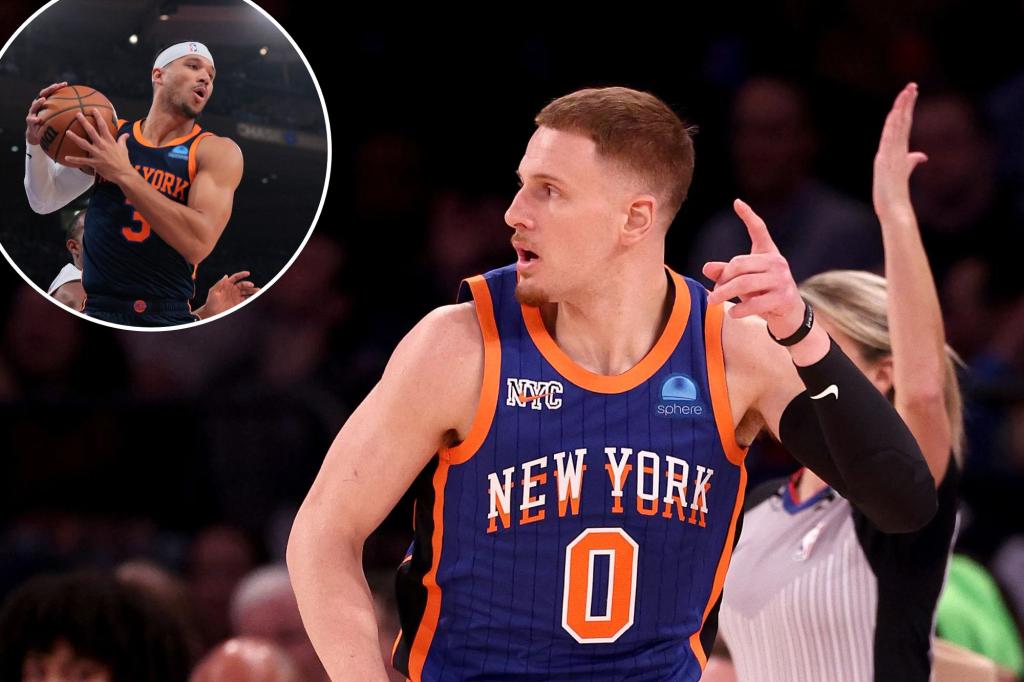One change hasn’t hurt the Knicks’ second unit.
In fact, early on the group appears to be improved.
The Knicks may have lost size by trading Obi Toppin to the Pacers and replacing him with another guard, free agent Donte DiVincenzo, but the transition has so far been relatively smooth.
“Probably the chemistry, on and off the floor, in a short amount of time,” is what has stood out about the bench to Immanuel Quickley, last year’s Sixth Man of the Year runner-up said. “I think that’s pretty special. When you can have guys connect and gel right off the bat without much time together is always a sign of something that can be special.”
The numbers back it up.
So far this season, albeit in just six games, the quintet of RJ Barrett, Isaiah Hartenstein, Josh Hart, Quickley and DiVincenzo are outscoring the opposition by 3.1 points per 100 possessions.
Barrett, Hartenstein, Hart, Quickley and Toppin, by contrast, outscored the opposition by 0.5 points per 100 possessions last year.
This new unit is moving the ball well, producing an assist percentage of 73.2.
Most importantly, their lack of size hasn’t been a problem on the boards.
Their rebounding percentage is 52.3, which is even higher than the starters’ rate of 52 percent.
“I said this yesterday about Josh being at the four: Everyone was concerned about the size thing,” coach Tom Thibodeau said. “But Josh, to me, he can defend and he’s a great rebounder. Our rebounding has been terrific so we’ve got to continue to do that.
“Josh really is a perimeter player. He just has the versatility that’s unique. … But usually when you downsize you sacrifice your defense and your rebounding. In Josh’s case we don’t do that.”
The strength of this group is its versatility, speed and shotmaking ability.
With four guards on the floor, the Knicks play extremely fast, registering a pace of 106.13 possessions per a 48-minute game.
Last year’s bench unit was at 102.79. The Wizards lead the NBA in pace this year at 105.69.
Other than Hartenstein, whoever gets the rebound can start the break themselves.
They can also seamlessly switch, thanks to positional versatility. Hart is technically playing power forward, but he can defend one through four.
The same could be said for Barrett.
“I love how the pace of the game changes with the second unit,” Thibodeau said.
While DiVincenzo is new, the other four members of the second unit played together last season, and that comfort with one another has carried over.
For instance, Barrett knows when Hart gets a defensive rebound to take off, because Hart will find him.
DiVincenzo, it should be noted, has started slow, averaging 7.3 points on 37 percent shooting. But his new teammates have raved about his penchant for doing the little things, like deflections, being a pest defensively and making the extra pass.
“Him as well as ‘Quick’ are those spark plugs for us,” Barrett said.
One of the reasons the Knicks were such a quality team a year ago was their depth, that there wasn’t a dropoff from the starters to the bench.
This season, their starting five has performed extremely well, outscoring the opponent by 17.8 points per 100 possessions.
And the reserves have often picked up where the opening five has left off, though not to that extreme extent.
“It keeps pressure on the other team all game long,” Barrett said.
Source









